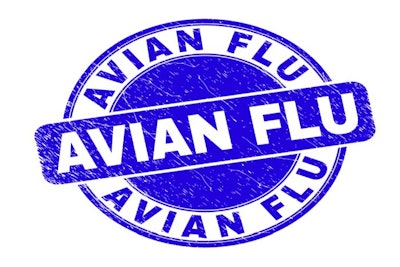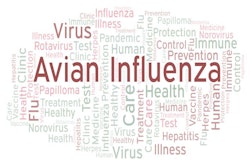
The first cases of highly pathogenic avian influenza (HPAI) in poultry of this winter have occurred in Denmark, Sweden, and new regions of Russia and Ukraine. Losses are mounting rapidly in parts of Italy, and the United Kingdom reports its worst ever outbreak.
So far this winter, 13 European states have officially registered at least one HPAI outbreak in poultry, with H5N1 as the dominant serotype.
Since the beginning of December, 12 European states have registered new outbreaks in their respective poultry sectors. This is according to the latest update of the Animal Disease Information System of the European Commission (EC; as of December 19).
By that date, a total of 1,597 HPAI outbreaks in poultry had been reported to the EC by 22 European states. This is an increase of 81 over the previous seven days.
For comparison, a total of 442 outbreaks of HPAI in poultry were registered through the EC system in 2020. In that year, cases were reported by 16 states, with Hungary the worst affected (273 outbreaks).
In 2021 to date, France has registered the highest number of outbreaks in poultry (482). The great majority of these were confirmed in the first half of the year.
Also confirming with the EC new outbreaks over the past week have been Poland (now with 382 outbreaks so far this year), Italy (243), Germany (241), Hungary (52), Czech Republic (44), Sweden (17), Bulgaria (13), The Netherlands (12), Northern Ireland (6), and the Republic of Ireland (5).
54 new HPAI outbreaks in Italian poultry flocks
Since the first HPAI cases of the season in the country on October 19, 261 outbreaks have been confirmed in Italy. This is according to the nation’s health authority and research organization for animal health and food safety, IZSVe (as of December 21). In each case, presence of an H5 HPAI has been confirmed, and the H5N1 serotype has been confirmed in the majority of cases.
Since the previous update on December 12, there have been 54 new outbreaks — all on farms. Accounting for half of these are meat turkeys. Also affected have been broilers (13 outbreaks), laying hens (10), and one each in chicken breeders, pheasants, game birds, and guinea fowl. Latest cases have been in three provinces in the Veneto region, and two in Lombardy, where previous cases are reported.
IZSVe reports no longer include the number of birds affected in each outbreak. However, more than 12.22 million poultry have been directly involved in the country’s outbreaks to December 17, according to data supplied to the World Organisation for Animal Health (OIE).
First outbreaks in four regions in north Europe
Last week, first cases of HPAI linked to the H5N1 variant were detected in Denmark since early November. According to the official notification to the OIE, affected was a farm in the Central Denmark region with 6,000 pheasants and mallard ducks. The birds are reared to restock game for hunting. Around 100 of the birds died.
In Ukraine, an H5 HPAI virus was detected in a backyard flock in Kherson earlier in December. Affected were 155 poultry, 76 of which died. Last outbreak in this southern region was at the end of April this year.
First cases of HPAI linked to the H5N1 serotype have also been detected in Sweden. According to the OIE report, 150 meat turkeys died at a farm in the southernmost county, Skåne, in the second week of December. To control the spread of the infection, almost 6,000 remaining birds at the affected premises were culled. This virus serotype was last detected in Sweden in 2006.
The EC system does not monitor animal health in Russia. However, the country’s veterinary authority has notified the OIE about the return of the H5N1 serotype to the Rostov region. Almost 41,000 of the 424,000 poultry at the affected farm have died. The virus was last detected in this Southern federal district region in May of this year. However, reports to the OIE indicate its presence in wild birds and non-commercial flocks as recently as November.
Further HPAI cases in central and eastern Europe
Since mid-December, Hungary’s veterinary authority has reported 28 new outbreaks to the OIE. Latest to be affected by the disease were 14 premises in Bacs-Kiskun, nine in Csongrad, four in Hajdu-Bihar, and one in Bekes. All these counties adjoin in the south and east of the country. All the affected premises were described as farms, and the majority were raising ducks or geese for meat or foie gras. The largest flock comprised around 59,000 birds. Another around 2,400 breeding geese.
Over the past 10 days, Poland’s animal health agency has informed the OIE about a further 14 HPAI outbreaks. While two were in backyard flocks, the others were on commercial farms. They bring to 388 the number of HPAI outbreaks in Poland so far this year,
Latest Polish outbreaks include the first of this winter in Warmia-Masuria in the north of Poland and neighboring Kuyavia-Pomerania. There are further cases in the central provinces of Greater Poland and Lodz, as well as in Slaskie in the south-west.
Last week, one new outbreak was reported in Bulgaria by the country’s food safety agency. Affected was a flock of around 7,000 ducks in the central province of Stara Zagora.
A backyard flock of 71 poultry in the south of the Czech Republic has also recently tested positive for the H5N1 HPAI virus, according to a recent official report to the OIE.
H5N1 HPAI situation in western Europe
Over the past two months, more than 60 HPAI outbreaks linked to the H5N1 virus have been confirmed across the United Kingdom (U.K.), reports the agriculture department, Defra. This is the U.K.’s largest ever HPAI outbreak series.
Chief Veterinary Officer Christine Middlemiss has urged poultry keepers to maintain the highest possible levels of biosecurity. Since November, it has been a legal requirement for bird owners to keep their flocks indoors, and to follow strict biosecurity measures.
According to the respective authority, 55 outbreaks have been confirmed in England, five each in Scotland and Northern Ireland, and three in Wales.
Four new outbreaks linked to the same virus variant have occurred in Germany. Poultry have tested positive for the same virus variant at two farms in Lower Saxony, and one in North Rhine-Westphalia, as well as in a Bavarian backyard.
Meanwhile, the French authorities have informed the OIE about a further three outbreaks in poultry. These bring to eight the number of confirmed outbreaks in France over the past month. Directly impacted have been more than 247,000 commercial poultry.
During the second week of December, the H5N1 virus was detected at two farms near to Dunkirk in northern France. Part of Nord, this is the department where previous recent outbreaks have occurred.
Also in France, the first outbreak has been confirmed in the southwestern department of Gers. Affected was a duck flock prior to force-feeding. This is the region that bore the brunt of HPAI outbreaks last winter, when almost 500 outbreaks linked to the H5N8 virus resulted in the culling of around 3.5 million poultry.
One new HPAI outbreak has been reported in the Netherlands. According to the latest report to the OIE, affected was a farm with around 59,000 poultry in the eastern province of Overijjssel.
HPAI outbreak total in European wild birds passes 2,300
So far this year, 31 countries in Europe have registered a total of 2,312 HPAI outbreaks in wild birds with the EC (as of December 19). For comparison, a total of 756 outbreaks in 13 of the region’s states were registered with the EC over the whole of 2020.
Since the start of December, 20 states have confirmed one or more cases of HPAI in wild birds through this notification system. The latest count is 64 more than the total on December 12, with Germany accounting for 30 of this increase. Also registering new wild bird cases with the EC over the past week were Austria, Belgium, Denmark, France, Hungary, Irish Republic, Italy, Luxembourg, the Netherlands, Norway, Poland, Sweden, and Ukraine.
For the first time ever, the H5N1 HPAI virus has been detected in the Faroe Islands. According to the official report to the OIE, two dead seabirds tested positive for this serotype during September. An island archipelago in the North Atlantic Ocean, the Faroes are self-governing, and part of the Kingdom of Denmark.
View our continuing coverage of the global avian influenza situation.

















